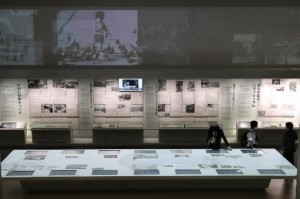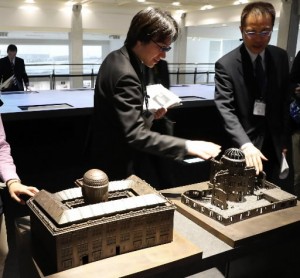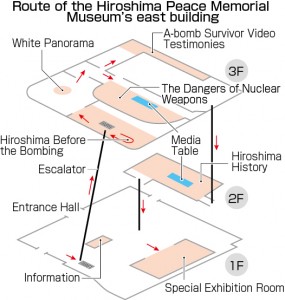Peace Memorial Museum’s east building uses state-of-the-art technology and conveys global conditions of nuclear arms
Apr. 26, 2017
by Kanako Noda and Kyosuke Mizukawa, Staff Writers
New exhibits in the east building of the Hiroshima Peace Memorial Museum, located in Naka Ward, can be seen by the public when the building reopens on April 26. The new exhibits are part of the first full-scale renovation work since the east building opened in 1994, and state-of-the-art imaging technology has been added. The museum staff has reorganized the information about the atomic bombing and emphasized ways to convey this information more effectively.
The previous route through the museum had visitors entering in the east building and exiting from the main building, but this route has changed, and now the entrance and exit are both located in the east building. After taking a newly-installed escalator to the third floor, visitors view the introductory exhibits that show the city center before and after the atomic bombing.
Various techniques to convey information
Photographs showing the charred city center surround “White Panorama,” a diorama measuring five meters in diameter that depicts the city center at the time of the A-bomb blast by making use of computer graphic projections. The sensation of standing in the ruins is emphasized, and explanations are intentionally omitted.
The information on the panels of “Hiroshima History,” on the second floor, and “The Dangers of Nuclear Weapons,” on the third floor, are divided into small sections to make them easy to read. If visitors want to learn more, they can search for the information they want by using “Media Table” computers, which have been installed on both floors. Using touch-screens, they can retrieve explanations and details about images.
Models of the Hiroshima Prefectural Industrial Promotion Hall before and after the atomic bombing, when it became the Atomic Bomb Dome, located in Naka Ward, have been made on a scale of 1:100, using a three-dimensional printer. Through this hands-on exhibit, visitors can examine the destructive force of the atomic bomb. Visitors can also compare an A-bombed roof tile and a glass bottle deformed by the bomb’s intense heat with real objects that were not exposed to the atomic bomb.
Trend toward nuclear abolition
The trend taking place in the international community toward the abolition of nuclear weapons is described on the panels of “The Dangers of Nuclear Weapons.” These panels provide explanation about global conditions, including the fact that the United States and Russia concluded the New Strategic Arms Reduction Treaty (New START) in 2010 during the Obama administration. One panel explains a treaty that would ban nuclear arms, which many A-bomb survivors have been calling for the world’s nations to conclude.
Some of the panels are designed so they can be updated with information that reflects current conditions. For the time being, the panel with information on North Korea mentions two nuclear tests conducted by that nation last year. The museum plans to update this panel on an annual basis.
(Originally published on April 26, 2017)
New exhibits in the east building of the Hiroshima Peace Memorial Museum, located in Naka Ward, can be seen by the public when the building reopens on April 26. The new exhibits are part of the first full-scale renovation work since the east building opened in 1994, and state-of-the-art imaging technology has been added. The museum staff has reorganized the information about the atomic bombing and emphasized ways to convey this information more effectively.
The previous route through the museum had visitors entering in the east building and exiting from the main building, but this route has changed, and now the entrance and exit are both located in the east building. After taking a newly-installed escalator to the third floor, visitors view the introductory exhibits that show the city center before and after the atomic bombing.
Various techniques to convey information
Photographs showing the charred city center surround “White Panorama,” a diorama measuring five meters in diameter that depicts the city center at the time of the A-bomb blast by making use of computer graphic projections. The sensation of standing in the ruins is emphasized, and explanations are intentionally omitted.
The information on the panels of “Hiroshima History,” on the second floor, and “The Dangers of Nuclear Weapons,” on the third floor, are divided into small sections to make them easy to read. If visitors want to learn more, they can search for the information they want by using “Media Table” computers, which have been installed on both floors. Using touch-screens, they can retrieve explanations and details about images.
Models of the Hiroshima Prefectural Industrial Promotion Hall before and after the atomic bombing, when it became the Atomic Bomb Dome, located in Naka Ward, have been made on a scale of 1:100, using a three-dimensional printer. Through this hands-on exhibit, visitors can examine the destructive force of the atomic bomb. Visitors can also compare an A-bombed roof tile and a glass bottle deformed by the bomb’s intense heat with real objects that were not exposed to the atomic bomb.
Trend toward nuclear abolition
The trend taking place in the international community toward the abolition of nuclear weapons is described on the panels of “The Dangers of Nuclear Weapons.” These panels provide explanation about global conditions, including the fact that the United States and Russia concluded the New Strategic Arms Reduction Treaty (New START) in 2010 during the Obama administration. One panel explains a treaty that would ban nuclear arms, which many A-bomb survivors have been calling for the world’s nations to conclude.
Some of the panels are designed so they can be updated with information that reflects current conditions. For the time being, the panel with information on North Korea mentions two nuclear tests conducted by that nation last year. The museum plans to update this panel on an annual basis.
(Originally published on April 26, 2017)










